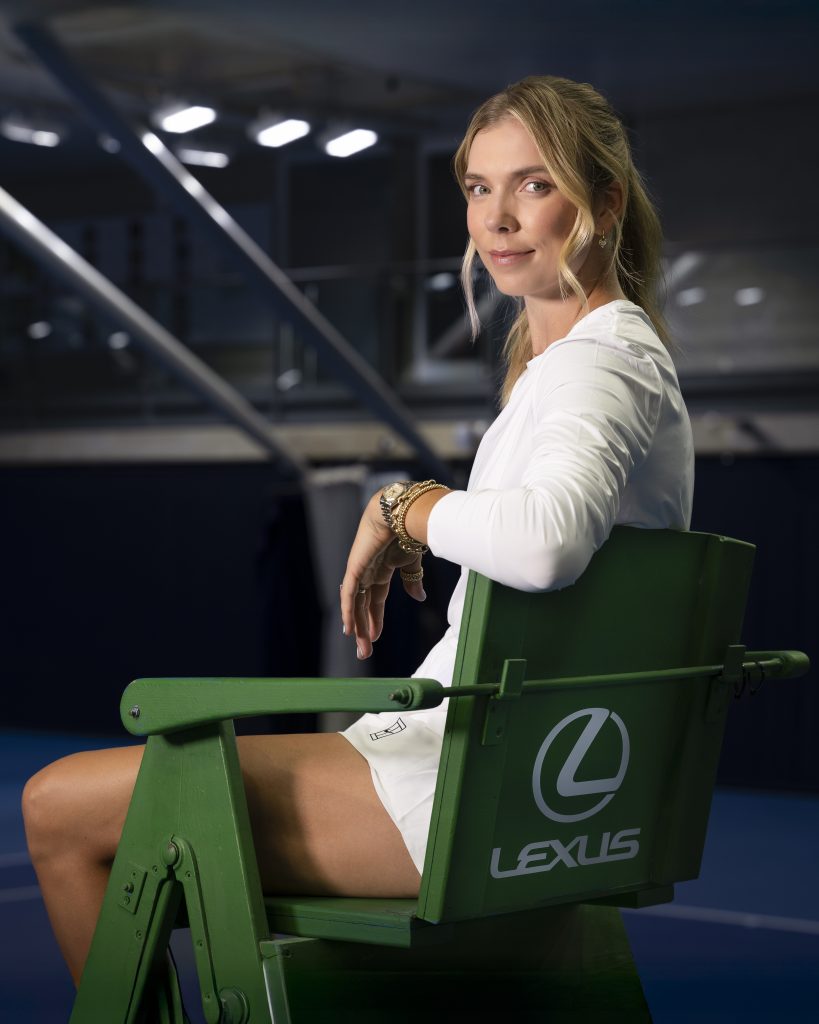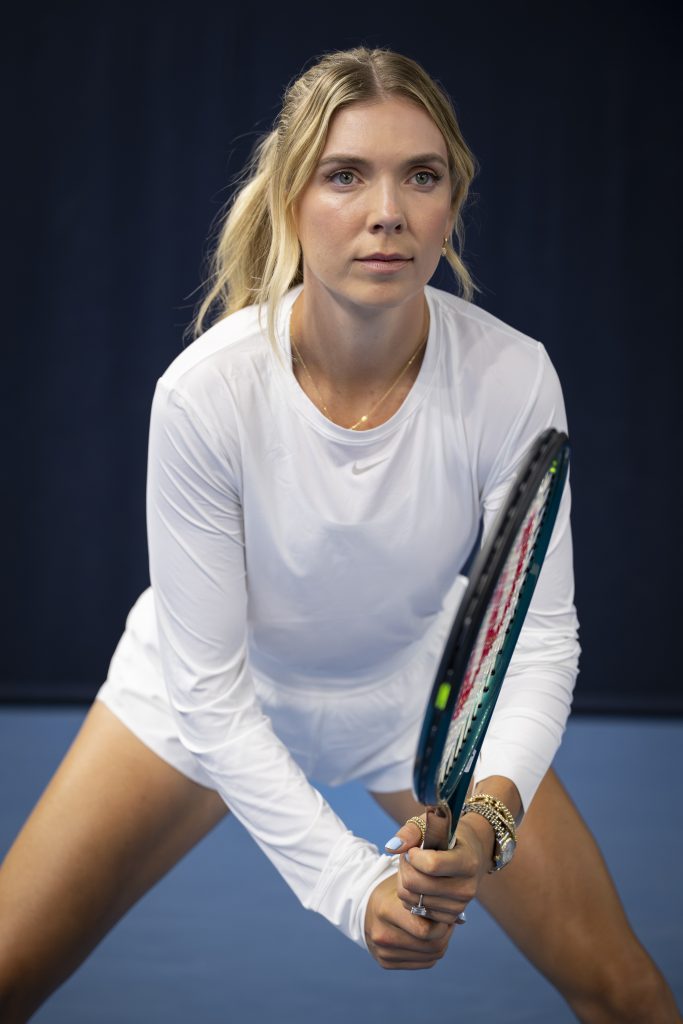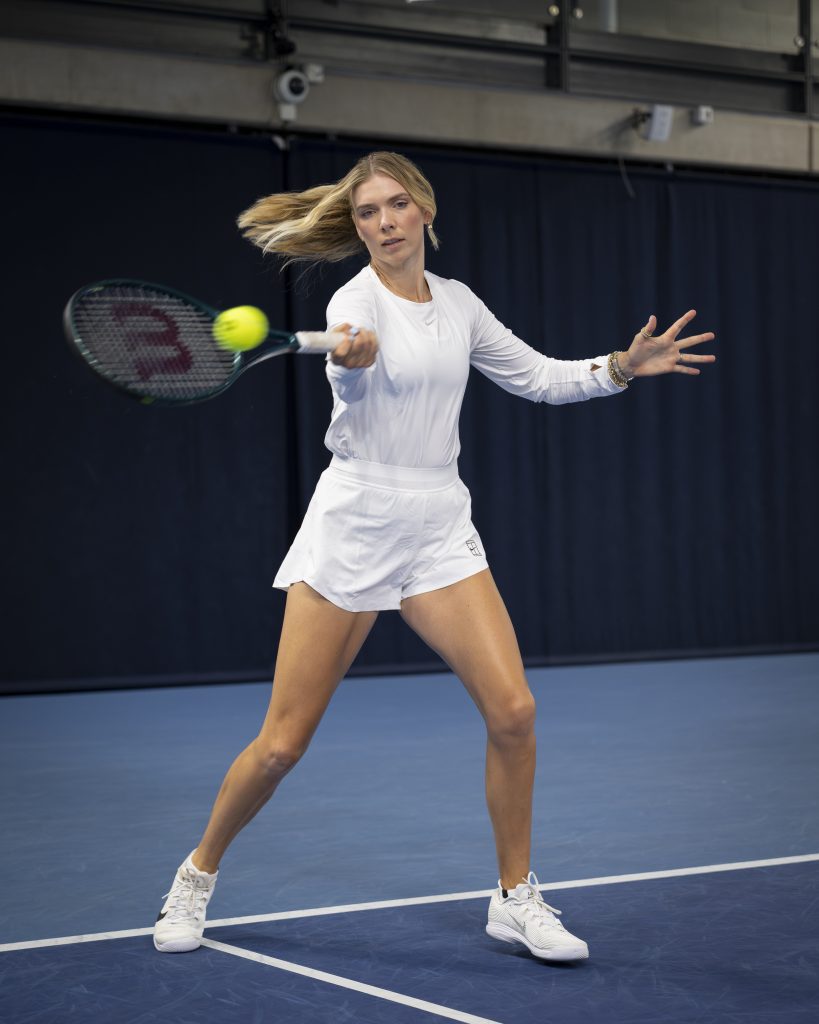Britain’s number one female tennis player and Lexus ambassador, Katie Boulter, gives tips on starting in tennis
Katie Boulter is at the top of her game as Britain’s current number one female tennis player, but she has strong memories of what it was like starting out in the sport as a child. As a Lexus ambassador, she supports the brand’s drive to encourage grassroots tennis across the country through its partnership with the Lawn Tennis Association (LTA). In this exclusive interview she shares her tips on how to get started in tennis:
What should you wear to play tennis? Do you need to buy specific tennis gear, or will sports leggings and trainers suffice?
A: Personally, I love mixing and matching different kinds of sports and athleisure wear and I particularly love the yoga Nike leggings, so I wear them a lot. I think you can play tennis in pretty much anything which is athleisure related.
However, with trainers I would be a little bit more cautious. Tennis shoes are designed specifically for tennis movements, so I wouldn’t recommend using running shoes on court.
What other tennis equipment, kit or training aids are useful for a beginner?
I recommend some warm-up equipment and some resistance bands for your shoulders and the rest of your body. I think it’s important to warm the shoulders up before you start practising, to help prevent injury.
In terms of training aids that are useful for a beginner, I recommend using different coloured balls. As you go through the tennis ranks, you start off with a soft sponge ball and then you progress to different coloured balls with different pressure, which tend to stay in the air for longer and so are easier for a beginner to hit*, before transitioning to a full-pressured yellow ball.
• * Red balls – designed for beginners and are oversized, unpressurised, or made from foam rubber. They bounce slowly and stay in the air longer, making them easier to hit
• Orange balls – these are unpressurised normal-sized balls, but travel faster than red balls
• Green balls – these are half-pressurised normal-sized balls, so they are slightly faster than orange balls
• Yellow balls – these are the standard size and are fully pressurised and are the balls used in professional tennis
Do you need to be super fit to start playing tennis?
Absolutely not! That’s the best part about tennis; anyone can play, at any age, any level, in any shape. It’s great to get out and play tennis and anyone can enjoy it. That’s why it’s a unique sport and challenges everyone.
How can local clubs help people get into tennis and cater for all abilities?
Local clubs can make tennis quite a social event and I think for some generations, such as older people, or kids, having time over lunch or a drink when people can sit and chat, makes it quite a social activity, rather than an intense, serious session. For kids, tennis clubs can provide different equipment and games like balloon tennis, which can get them into the sport more easily, is super fun and encourages early skills.
Early skills
What are the most important shots to get under your belt as a beginner?
As a beginner, I would start with the forehand.
What about the serve? How should a beginner approach this and how would they know when to move to overhead serves?
I think it’s important to start with overhead serves. I think it’s a good idea to get a little bit of strength in using your arms above your head. As mentioned earlier, balloon tennis is a good idea to help start with that shot, where you throw the balloon up and it will stay in the air for a relatively long time, so naturally you will always have to reach over your head. You’re performing an overhead serve without even trying. And after that, on the tennis court, practise the ball toss. Just throw the ball up right in front of you, then try to make contact with it if you can.
What goals should you set yourself as a beginner?
I feel goals are very specific to the individual. The biggest goal is just to have fun and to enjoy the process, because as a tennis player even at the top of the game, no one is perfect and no one has perfect days. So enjoy the process, enjoy the challenge.
How can you practise on your own? Can you recommend any simple drills or routines?
Yes you can absolutely practice on your own, all you need is a wall to hit the ball against. When I started growing up, I used a practice wall loads. A lot of the time I was just enjoying playing by myself and I think that’s a good starter for someone who wants to hit a lot of balls and spend a bit of time on a tennis court, so hitting against a wall is great at any level.
What can a beginner learn from watching the pros at tournaments?
It’s a great idea to watch the footwork, not thinking too much about the strokes, but actually observing how much the players move to get themselves into position. The adjustment steps they take are some of the most important to get themselves aligned with the ball. So just noticing how many steps it takes to get into position, to then take a stroke, is one of the most important things in tennis.
Katie’s early memories of learning to play tennis:
What are your earliest memories about learning to play tennis?
My earliest memories are of playing tennis in my grandpa’s garden with a makeshift net. I was playing with my racquet that had multi-coloured strings and we would volley in the garden – me, my brother, my grandpa and my mum. We had little competitions and that’s how my tennis really started. I also started playing balloon tennis; it was about learning to compete and enjoy playing a sport. Then I moved into badminton and played this a lot in the garden, which is obviously good for hand-eye coordination, with a lot of moving and hitting. I just enjoyed competing and that’s what got me into tennis.
Did you ‘click’ with tennis immediately?
When I was young my parents introduced me to different sports, not just one. I think I naturally loved tennis more and I was around the sport more, as my mum was a tennis coach at the time and my grandparents played a lot of tennis, so I would always go down to the club and watch them play mixed doubles together. And that’s how I enjoyed my weekends – seeing them play tennis. So naturally I think I clicked a little bit more with it, but it wasn’t the be all and end all and I was also playing multiple sports: hockey, running, football, rounders.
What did you find most difficult when you were learning to play tennis?
The biggest thing was not being negative. It’s easy to lose a bit of focus and a bit of hope that what you’re doing sometimes isn’t the right thing. Naturally you won’t always see the outcomes that you want straight away in tennis and that’s what makes it really hard. You must persevere and keep going until the right moment when it finally clicks. I found that very difficult, because I expected that when you’re told to do something, you’ll automatically hit the perfect shot and it’s just not like that. It takes so many repetitions and time to get to a point that you can do it more frequently, but you still don’t get to a place where it’s perfect every single day, so learning to be patient was big for me.
Tell us a little about your first club/ training session
Actually my first sessions were with my mum, because as I mentioned she was a tennis coach when I was a little girl and we used to go down to the local club, Leicestershire Lawn Tennis Club, which I absolutely loved. It was such a big community of tennis players of all ages and I spent a lot of time there. I specifically remember the club championships. We used to sit on the roof of the tennis club and look out onto all the courts and you’d see everyone was playing matches and I just really enjoyed that day because there was a buzz of competition, so it was something I looked forward to in the year.
What is your advice for someone who is keen to have a go at tennis but doesn’t know where to start and is worried they’ll make a fool of themselves?
I think it’s important to know that every single tennis player, including the pros, have made a fool of themselves at some point. All of us have fresh-aired a shot and done something we were worried about and it’s completely natural. You just have to laugh at yourself, enjoy it, because we’ve all been there. Even today we all have days where it just doesn’t go quite right, but it’s your mindset that will bring you back and make you enjoy the sport even more. So I think for someone who’s keen to have a go at tennis, be very patient, enjoy yourself and have fun.
About Lexus and tennis
Lexus is the Official Performance and Automotive Partner to the LTA and a Premium Event Partner for the HSBC Championships and has the event naming rights for the summer grass court tournaments at Nottingham, Ilkley and Eastbourne. It is providing the official hybrid and battery electric vehicles for these events, including the RX hybrid and RZ all-electric SUVs, helping the LTA reduce its carbon footprint.
It is also the headline sponsor of the national teams competing in the Billie Jean King Cup, Davis Cup and World Team Cup, while at grassroots level, it is the lead partner of the LTA Awards, celebrating the work of coaches and volunteers nationwide.
ENDS





